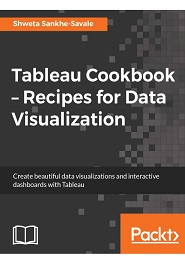
English | 2016 | ISBN: 978-1784395513 | 504 Pages | PDF | 19 MB
Create beautiful data visualizations and interactive dashboards with Tableau
Data is everywhere and everything is data!
Visualization of data allows us to bring out the underlying trends and patterns inherent in the data and gain insights that enable faster and smarter decision making.
Tableau is one of the fastest growing and industry leading Business Intelligence platforms that empowers business users to easily visualize their data and discover insights at the speed of thought. Tableau is a self-service BI platform designed to make data visualization and analysis as intuitive as possible.
Creating visualizations with simple drag-and-drop, you can be up and running on Tableau in no time.
Starting from the fundamentals such as getting familiarized with Tableau Desktop, connecting to common data sources and building standard charts; you will walk through the nitty gritty of Tableau such as creating dynamic analytics with parameters, blended data sources, and advanced calculations. You will also learn to group members into higher levels, sort the data in a specific order & filter out the unnecessary information. You will then create calculations in Tableau & understand the flexibility & power they have and go on to building story-boards and share your insights with others.
Whether you are just getting started or whether you need a quick reference on a “how-to” question, This book is the perfect companion for you
What You Will Learn
- Get to grips with the Tableau workspace and terminologies and understand what data sources you can connect
- Learn to create basic charts like bar chart, stacked bar, pie chart, line chart, area chart, tree map & word cloud
- Go even further with more advanced visualizations such as scatter plot, box & whiskers plot, dual axis, bullet chart, Histograms, Maps, etc
- Use pre-defined calculation and change its scope and direction to affect outcome
- Learn to define Parameters and call them into parametric calculations that provide outcomes based on user inputs
- Build Dashboards and use Actions to link multiple sheets on the dashboard
- Connect to multiple data sources using Data Blending, Multiple Table Join within the same data source as well as across data sources, Custom SQL and learn to work with data Extracts
- Compute statistical trends, build forecasting models and use Reference lines for benchmarking
Resolve the captcha to access the links!